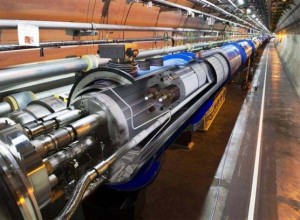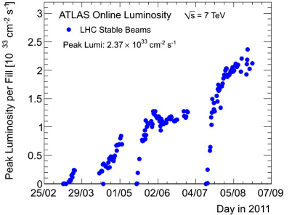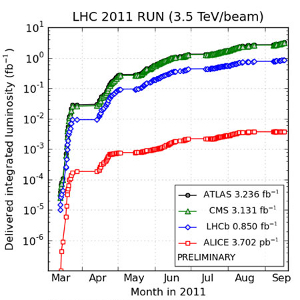The Tevatron at Fermilab, US, was turned off last week and now the high energy frontier has officially moved across the Atlantic Ocean to CERN and its Large Hadron Collider (LHC) in Switzerland. We have great expectations for LHC physics, since historically higher energy has been our most effective probe to new discoveries in particle physics. The LHC is now operating at 3.5 teraelectronvolts (TeV) per beam and will eventually run at twice that energy. The machine is already performing quite well and is in the midst of a physics data-taking run that is scheduled to extend to the end of 2012. We anticipate significant science results will emerge from this data run.
LHC is built in the tunnel that housed LEP, a high-energy electron-positron collider that provided much of the precision data validating the Standard Model of particle physics. The LHC consists of about 8000 superconducting magnets cooled to liquid helium temperatures (1.9 kelvins). The 1232 dipole magnets are each 14.3 metres long and will operate up to 8.4 teslas. They have twin apertures, enabling acceleration and collision of protons counter-rotating (note that the Tevatron produced antiproton-proton collisions). The energy stored in the magnet system is about 10 gigajoules.
The present LHC data run at 3.5 TeV began last winter and the performance of the machine has steadily improved during the run, achieving a peak luminosity of 2.7 x1033 cm-2 s-1. As of 26 September, it achieved an integrated luminosity of 3.6 inverse femtobarns, greatly exceeding the original 2011 goal of one femtobarn. The machine is now running with 1380 bunches and scientists are now working to increase the bunch intensity to 1.55 x 1011 protons per bunch.
This first important LHC data run is expected to continue to the end of 2012, with a roughly five-week heavy ion (lead-lead) run inserted at the end of this year. Some continued improvements in luminosity and maybe even some increase in energy are possible for the 2012 running. The accumulated luminosity projected by the end of 2012 should enable definitive searches for the Higgs boson over the entire mass range, except for the challenging low energy (around 120 GeV) regime, where only a preliminary search will be possible.
The question for us in the ILC effort is whether this LHC data run will produce enough physics results to motivate a linear collider, and whether it will give us the guidance we seek regarding the parameters required for such a machine, such as beam energy. Answer: probably not! Although important physics results are anticipated and will give us important early guidance, it appears likely that the data run, following the anticipated long shutdown from 2013-2014, will be required to really understand what new physics is emerging in this new energy regime.
Keeping this longer timescale in mind, those of us involved in the linear collider efforts are thinking hard about how best to incorporate the LHC guidance into the ILC design as it emerges. We will complete the major milestone of producing an ILC Technical Design Report (TDR) by the end of 2012, and the question that faces us is how to continue and update the design during the post-TDR period. I will be addressing this important question in future columns.





Recent Comments